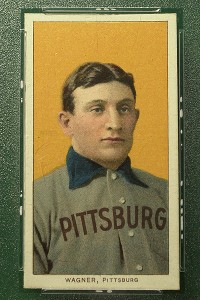|
The Honus Wagner Card, the "Holy Grail" of Sports Cards By Jeff Figler
Retracing history, Honus Wagner was an all-star shortstop for the Pittsburgh Pirates. He is regarded by many as being the premier player in the major leagues prior to the 1920s. Indeed, his highest achievement came in 1936 when the Baseball Writers Association of America selected him and Ty Cobb, Walter Johnson, Christy Mathewson and Babe Ruth, for the Baseball Hall of Fame’s inaugural induction. From 1909 to 1911 the American Tobacco Company issued the T206 (the T was for tobacco) set of cards on two brands of cigarette boxes, Piedmont and Sweet Caporal. It is estimated that only 35-50 authentic Wagner cards exist today. There are two prevailing reasons for the scarcity of the card. The first theory is that Wagner requested that the production of his card be stopped because he did not want children to be influenced into buying tobacco products, since it was being used as a marketing tool. This theory has been disputed because Wagner himself was a smoker. The other theory is that he was not paid by the tobacco company for the use of his image, and he requested that they stop production. The fact remains that a minimal number of cards exist today, and the value of the scarce Wagner cards continues to escalate. A bit of history about the Wagner values. In 1933, a card collector from Syracuse, New York, Jefferson Burdick published "The American Card Catalog" which was the first attempt to organize trading cards. Most cards were valued at less than $1, while the Wagner card was $50. In 1985, Bill Mastro, a sports-collectibles dealer bought a Wagner card, the only one known to be in mint condition, in a private sale for $25,000. This card was later sold in 1987 to a West Coast collector Jim Copeland. Four years later Copeland offered the card for auction on Sotheby’s, and was purchased for $451,000 by hockey star Wayne Gretzky and Los Angeles King’s owner Bruce McNall. Later that year recently-formed Professional Sports Authenticator, Inc. (PSA) of Newport Beach, California graded the card a "PSA NM-MT 8". The grading of this card set this card apart, and from that time on this card has unquestionably been the most desirable trading card in the world. In 1995 Gretzky sold his card to Wal-Mart and Treat Entertainment for $500,000, to be used in a promotional contest. The contest was won by a Florida postal worker, Patricia Gibbs, who needed to sell it to pay the taxes on it. Christie’s auctioned it for $640,000 to Michael Gidwitz of Chicago. In 2000 Gidwitz sold it on eBay to Brian Seigel for $1.265 million, who in 2007 sold it for $2.35 million. Later that year the card was sold to Ken Kendrick, owner of the Arizona Diamondbacks for $2.8 million and when you add the buyer’s commission the total price comes to about $3.1 million dollars. Naturally, the escalation of the one card (often called the Gretzky T206 Wagner card) has also raised the values of the other 35 or so Wagner cards which are in a lesser condition. The controversy surrounding the "Gretzky card" is whether it has been trimmed and "doctored", which to many card collectors is a vice. There is speculation that the pristine Wagner card was part of a T206 uncut sheet that landed in the hands of the party that sold that card, and the others from the sheet, to Mastro. If the cards were cut from a sheet, then they were not from the bottom of a cigarette box. Also, there are even rumors whether the PSA authenticators acted in good faith when they graded the card, as its policy is not to grade cards from sheets and cards that may have been altered. Despite the controversy of the card and how it came to be, the Wagner card is the "Holy Grail" of trading cards. It is likely that the full truth if, and how, the card was trimmed, will never be known, and as time goes on, the rumors about it will simmer. Jeff Figler has authored more than 500 published articles about collecting. He is one of the world’s leading experts on collectibles and is a former sports columnist for the St. Louis Post-Dispatch/STL Today, and San Diego Union Tribune. Jeff’s most recent book is "Collecting for Beginners". You can learn more about Jeff by visiting his website www.collectingwithjeff.com |
|
|
